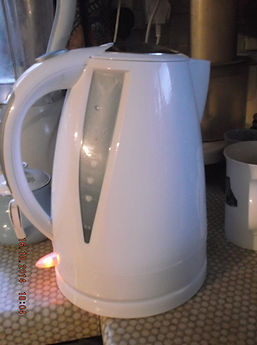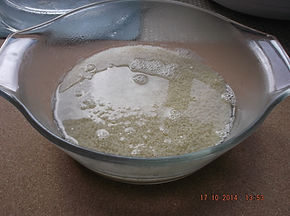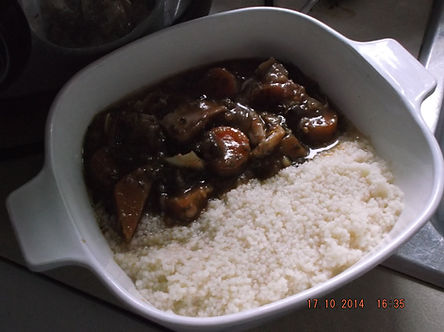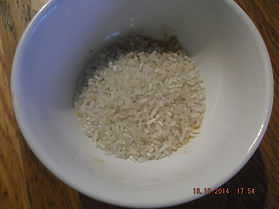top of page
Good Cheap Grub ! Eating well on a low budget
Perpetual Stew .
Begin by chopping some vegetables : Here I used 1 small onion , 1 medium/large carrot , about 1 third of a swede and 1 ('home grown' !) whole chilli , roughly chopped . If you haven't got , or don't like, whole chilli then use about a teaspoon of another type of pepper , such as ordinary ground white pepper .
IMPORTANT HYGEINE RULES FOR THIS STEW :
1: Never eat directly out of the pot because if you place a used utensil ( eg : spoon) into the stew it will become infected and deteriorate quickly .
2: Keep the stew in a cool place inbetween cooking periods


To these ingredients I added 1 teaspoon of Turmeric , 1 teaspoon of mixed dried herbs , 1 teaspoon of ginger and some dried 'all spice' berries ( or use 3 or 4 teaspoons of curry powder instead of pepper and spices). Then a handful of rice ( mainly for thickening ) . I also added some small green lentils ( 'lentils vertes' ) ; you could use ordinary green lentils or 'red' ( small orange split ) lentils , but some types of lentils need to be soaked first , so be careful about this or they won't cook properly ; N.B : If you really don't like hot spices you could use 'mixed spice' from the baking aisle, or a teaspoon or two of Garam Masala , which is an Indian spice mix that usually contains no pepper .



Switch on the slow cooker and heat some fat or oil in it . Add all the ingredients and a couple of Chicken drumsticks ( if you are Vegetarian , just increase the amount of vegetables ).
IMPORTANT : Cover the slow cooker .
Then leave it to cook on high for around 40 minutes or low for around one hour ; stir halfway through ( N.B This stage is not entirely neccessary , but if you miss it out the results probably won't be as good ; you could alternatively do this stage more quickly, on a moderate heat in a pan , but this involves more effort ) .


I also eventually added some mushrooms that were 'past their best' ; the long simmering of slow cooked food will often solve this kind of problem with vegetables ; never cook 'off meat ' though ; it might make you very ill . Vegetables are usually O.K until they become slimy ( but you shouldn't eat green or sprouting potatoes ; apparently they are toxic ) . Vegetables can often be salvaged by cutting the bad bits off and just use the good parts .


Eventually everything will be a bit steamed and fried .
Now boil about a litre of water in kettle , and then add the hot water till the ingredients are all just covered .
NB: it's important to use hot water . It speeds up the cooking time by at least an hour.




Add to this one tablespoon of tomato puree ( or a can or half a can of tinned tomatoes ) , one teaspoon of sugar and half a teaspoon of salt. It's also a good idea to add a small clump of frozen spinach , to increase nutrition , but be careful because too much spinach will make a stew slimy :



Almost finished ! Now cover the slow cooker , make sure it's on HIGH , bring it to the boil
( just check by looking ! ) then turn it to low and let it simmer for at least an hour . Cook it long enough and the chicken will virtually fall of the bones ( with the aid of a fork ) .
Stir it up and it's ready !



Switch off the slow cooker and make sure it's left somewhere fairly cool and with a cover on , to discourage germs and rot etc..........
The 'Perpetual Stew' is TO BE CONTINUED soon !
Before I continue with the stew , here's an idea for an accompaniment ; you could ,of course, eat this with pasta , rice , mashed potatoes , bread , buttered toast or even chips if you liked , but I recently discovered an easy way to cook couscous that I've decided to share here , so here goes ........
In a large bowl sprinkle couscous about 3mm deep and boil a kettle:


Just cover the couscous with boiled water , cover with a lid or a plate, and leave for a few minutes ; the couscous will quickly absorb the first lot of water . Add a large pinch of salt


It should look like this first picture ; cover it with water again , and replace the lid . Leave it for about 10 to 15 minutes .



IThe finished result should look like this ; shown here with my 'finished meal' . I got two meals like this out of the stew , with some left over to continue the recipe with .


So this will provide two modest 'main meals' to be eaten over a period of one or two days ( you can reheat the stew in a saucepan or a microwave , if you have one) . You could , of course , increase the quantities to make more, if you like .
It's important to keep the cover on the pot and keep it in a cool place until the next phase of cooking , at most 2 days after the first phase ( meaning one day without necessarily cooking it ) . The principle here is that when you reboil the stew for a while , the boiling will kill any germs that are beginning to form and render the stew 'safe to eat ' .
PHASE TWO :
Now you add fresh ingredients to the remains of the stew in the pot ; apart from there being 'no waste ' , this actually causes some of the spices to 'mature' and the flavours arguably improve as a consequence.
So , in this case I used approx half a large cup ( half a 'mug' ) of a type of lentil called 'Toor Dal' ; if you can't find this type you could use ordinary Green Lentils or , at a push, the small orange 'Red Lentils' , but Red Lentils would make the result more 'sloppy' because they tend to dissolve . I also added more mixed herbs , a teaspoon full of 'coarse' black pepper ( this is split black peppercorns , and I highly recommend this type of pepper for cooking stews , it adds an amazing tanginess ) .
I also added a chicken stock cube ( see below ) :


Chuck the new ingredients into the pot , along with the remains of the stew ( a quarter or fifth of the original quantity ), boil about a litre of water and add it to the pot ( I would recommend leaving any large bones in the pot , as this tends to improve the stock ) :



Cover the pot , turn it to high and bring it to the boil. IMPORTANT : Boil the stew so it's bubbling well for at least 20 minutes, then reduce the heat to low and simmer it for at least another 30 minutes ( longer simmering is preferable ) . The result should be a thick broth ( see below ) :


I had some of mine with some of the left over couscous that I kept in the fridge for a couple of days . It doesn't look like much , but it tasted quite good ! Remember , you can reheat the stew and couscous in a saucepan or a microwave :

Switch off the slow cooker and make sure it's left somewhere fairly cool and with a cover on , to discourage germs and rot etc..........
O.K , if you're following this recipe and if you're anything like I was , you'll be on the fourth or fifth day now and since I don't want to push it to far , this is the last stage of the recipe. Now you will hopefully have left some of the thick broth in the pot , so the next stage is once again to add some new ingredients , but first take any bones out and get a potato masher or a fork and mash down any remaining bits in the broth ; this will allow the remaining part to dissolve and thicken what will now become a thinner soup at this stage ( it will also ensure that any remaining food will be ultra well boiled in this stage , thus increasing food hygeine ) :


Now it's time to add a smattering of new ingredients ; in this case I added another teaspoon of mixed herbs , another teaspoon of ginger and a beef stock cube , but you could use a couple of dessertspoons of oriental 'fish sauce' instead , or a combination of half a stock cube and a dessertspoon of fish sauce if you liked ( you could use soy sauce instead if you prefer ) ; be careful with these additions because stock cubes , fish sauce and soy sauce are all very salty and must be used quite sparingly .......


I also added a teaspoon of chilli powder and a teaspoon of sugar . Also chuck in another handful of rice . I just happened to have a few tiny home grown tomatoes so I added them to but this isn't necessary ; you can really add anything you've got ( within reason) at this point , or just leave it as it is . The basic idea is to make a thinner soup this time :



Put all this in the pot , along with the bones ( if you've still got them !) and then BOIL THE KETTLE and add around a litre of boiled water, turn the cooker on to high , cover it , bring it to the boil , let it bubble well for a while and then let it simmer on low for at least an hour :


After about an hour , check the soup ; if it doesn't seem thick enough then FOLLOW THESE INSTRUCTIONS CAREFULLY : Put a dessertspoon of ordinary flour in a small bowl and add a small quantity of COLD WATER . Mix this into a wet paste . Then add a bit more cold water , stir it and add it to the soup . Let the soup continue to cook
for another 20 minutes or so , or until it thickens . Be careful using flour for thickening because adding flour will dullen the other flavours :



The soup will hopefully be nice and spicy ! Since a soup like this is not very filling I would recommend serving it with a sandwich of some kind . This makes a nice light meal or 'big snack' , particularly for lovers of spicy food .

N.B : Please be aware that eating lentils or other types of pulses ( including Soya ) in large quantities over a period of two or three continuous days will give you the S.H.I.T.S no matter how they are cooked . If you continue to eat them over a longer period of time this can become painful ( as I discovered on numerous occasions in 1984 when I lived largely on lentil curry for a few months ) because it can actually make you sore etc... The best way to avoid this is to only use small quantities of them , or only eat them every other day , or eat them for two days and then avoid them for a day or two . Just thought I'd warn you !
Further Notes :
Why this Food is Healthy :
This food is healthy for a number of reasons .
Firstly the water in it hydrates the body , causing the organs to function better and increasing energy . Secondly it contains a lot of roughage ; this keeps various functions regular and has a cleansing effect on the body . The herbs and spices are medicinal , help the organs function better , can allieviate certain symptoms of illness and are also 'cleansing' . The pulses contain a certain amount of protein , the rice and couscous provide carbohydrates and small amounts of protein and the vegetables , tomatoes and tomato products provide some vitamins and minerals. Chicken contains a lot of protein. Using the bones might also increase the calcium content in the stew ( the bones seem to dissolve over a period of time ) . Another advantage of this type of food ( soup or stews ) is that none of the nutrients are lost because everything is consumed along with the 'cooking liquid' ; these means that more vitamins and minerals are retained .
Over a period of time , eating food such as this , at least occasionally , could improve your general health and help you to lose weight if you're overweight .
If eating food like this becomes a habit , it's probably a good idea to also occasionally include or eat extra green vegetables and also have some cheese or milk for extra
calcium .
Buying Spices :
If you find you like food like this it's a good idea to buy spices in 'bulk' in order to save money over a period of time . Spices can be expensive if you always buy the small bottles that are available , so look for the cardboard refill packs or ,better still, the bigger bags of spices that you can now get in many supermarkets ; these are sometimes more expensive than bottles but contain far more spice and are far cheaper per teaspoonful than the spice in bottles. Curry powder is a mixture of spices and is a good substitute for the individual spices . The spices will keep well for a few months if kept in a dry place or container with a peg to keep the bag closed .
Good luck with the cooking !
John
bottom of page